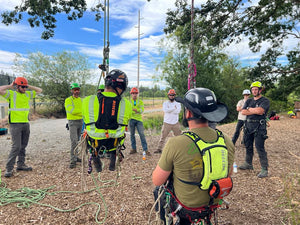Aerial Rescue Training: Building Skills That Save Lives
This blog spotlights a critical part of any at-height training program: aerial rescue.

The photos you’re seeing in this blog come from a recent session with first-year apprentices, under the guidance and expert instruction of Keith Blakeslee and Chase Ferris at Northwest Line Joint Apprenticeship Training Committee in Washington, U.S.A.
The focus of this training was victim packaging—a vital skill that begins on the ground and escalates into a fully simulated rescue scenario. Apprentices practice approaching, administering aid, packaging, and retrieving a “victim” from height, all while working under pressure. This isn’t a one-time lesson. Keith and crew revisit aerial rescue multiple times with every apprentice throughout their training. It’s a skill they treat with the utmost seriousness because in our world, it’s not a matter of if but when someone’s life may depend on it.

The Right Tools in the Right Place
One key component of successful rescue is having access to first aid on your person. Seconds matter in these scenarios, and what you carry can make the difference between life and death.
That’s where the DEPLOY stands out. It’s more than just a pouch—it’s a lifesaving tool that if dropped from a height, can easily be retrieved. This trauma kit can be attached to the rescuer or the rescued and accessed easily while tending to an injury.
Features like this don’t just make the job easier—they make it safer and more effective.
The team has also been using the Audax 1500 Hydration Pack for not only their hydration needs (you only need to be hit by heatstroke once to know you never want it again) but also for the Audax’s ability to be a 3-in-1 kit. Hydration, chest tether, and suspenders.
The DEPLOY uses the Audax’s laser-cut MOLLE attachment system to easily become a compact but still lightweight wearable trauma and hydration station.

Tools That Empower Rescuers
At the end of the day, the best rescue is the one you’re prepared for. If the victim can’t self-administer aid, a kit like the DEPLOY Trauma Kit provides the rescuer with everything needed at hand to stop haemorrhaging fast.
Aerial rescue isn’t just a box to be checked off. It’s a real-world issue that needs real-world application, and it’s fantastic to see this kind of high-level training being taught by the team at NW Line Training.
Check out the training they offer below:


